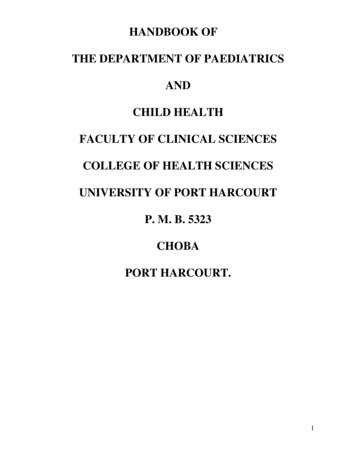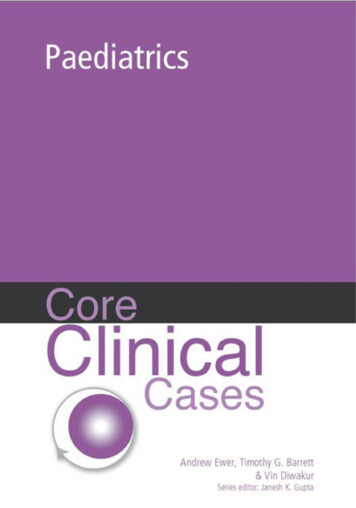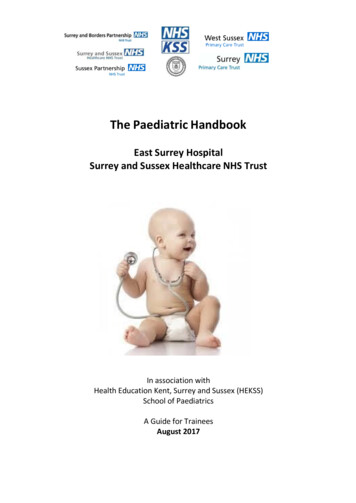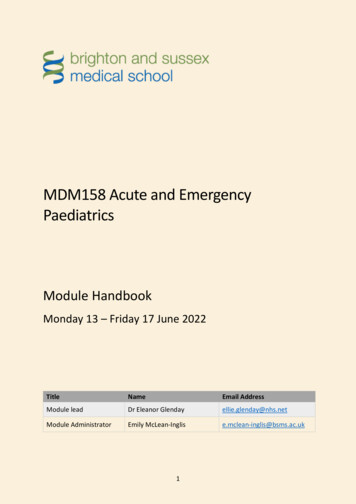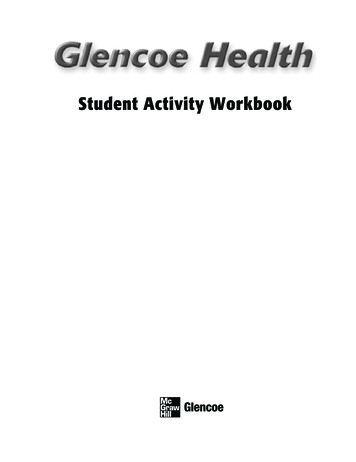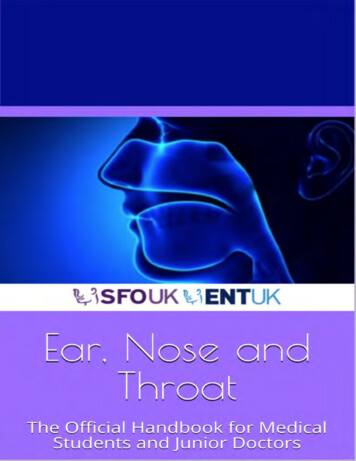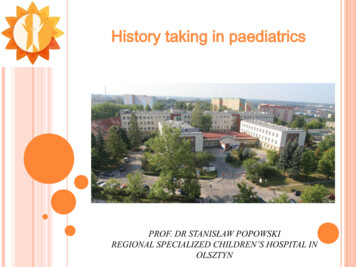
Transcription
History taking in paediatricsPROF. DR STANISŁAW POPOWSKIREGIONAL SPECIALIZED CHILDREN’S HOSPITAL INOLSZTYN
Paediatric history taking- Introduction Obtaining an accurate history is the critical first step indetermining the etiology of a patient's problem A large percentage of the time, you will actually be ableto make a diagnosis based on the history alone The value of the history will depend on your ability toelicit relevant information Successful interviewing is for the most part dependentupon your already well developed communication skills
Paediatric history taking- Introduction Observe the child at play in the waiting area and observetheir appearance, behaviour and gait as they come intothe clinic roomThe continued observation of the child during the wholeinterview may provide important clues to the diagnosis andmanagement When you welcome the child, parents and siblings,check that you know the child’s first name and gender
Paediatric history taking- Introduction Introduce yourself Determine the relationship of the adults to the child Establish eye contact and rapport with the family. Infantsand some toddlers are most secure in parents’ arms orlaps. Young children may need some time to get to knowyou Ensure that the interview environment is as welcomingand unthreatening as possible. Avoid having desks orbeds between you and the family, but keep a comfortabledistance
Paediatric history taking- Introduction Have toys available, observehow the child separates, playsand interacts with any siblingspresent Do not forget to addressquestions to the child, whenappropriate
Paediatric history taking- the history must beadapted to the child’s age Birth history and impact of children’s growth anddevelopment Often distracted by presence of the child Need to be flexible Maintain a sense of humourWhenever you consider a paediatric problem, whether medical, developmental orbehavioural, first ask, ‘What is the child’s age?’
Paediatric history taking- the history must be adapted tothe child’s ageolder children &teenagers There will be occasions when the parents will not want thechild present or when the child should be seen alone This is usually to avoid embarrassing older children orteenagers or to impart sensitive information This must be handled tactfully, often by negotiating to talkseparately to each in turn.
Opening the consultation-These questions may needto be addressed at the patient’s parents, depending on their age,so adjust asappropriate. Introduce yourself – name / role Confirm patient details – name / DOB Explain the need to take a history Gain consent to take a history Ensure the patient is comfortable
Presenting complaint Give the patient time to explain the problem/symptomsthey’ve been experiencing A paediatric history often relies on collateral informationfrom the parents It’s important to use open questioning to elicit thepatient’s or parent’s presenting complaint“So what’s brought your child in today?” or “What’sbrought you in today?” This can sometimes be difficult when talking to childrenand you may need to adopt an approach involving moredirect questioning. So instead of saying “Tell me aboutthe pain” you may need to ask a series of questionsrequiring only yes or no answers.
General enquiry General health – how active and lively? Normal growth Pubertal development (if appropriate) Feeding/drinking/appetite Any recent change in behaviour or personality.
Systems reviewMake sure that you and the parent or child mean the same thingwhen describing a problem General rashes, fever (if measured) Respiratory – cough, wheeze, breathing problems ENT – throat infections, snoring, noisy breathing (stridor) Cardiovascular – heart murmur, cyanosis, exercise tolerance Gastrointestinal – vomiting, diarrhoea/constipation, abdominal pain Genitourinary – dysuria, frequency, wetting, toilet-trained Neurological – seizures, headaches, abnormal movements Musculoskeletal – disturbance of gait, limb pain or swelling, otherfunctional abnormalities.
History of presenting complaint Onset – when did the symptom start? / was the onset acute or gradual? Duration – minutes / hours / days / weeks / months / years Severity – e.g. if symptom is shortness of breath – are they able to talk in fullsentences? Course – is the symptom worsening, improving, or continuing to fluctuate? Intermittent or continuous? – is the symptom always present or does it come andgo? Precipitating factors – are there any obvious triggers for the symptom? Relieving factors – does anything appear to improve the symptoms, e.g. aninhaler Associated features – are there other symptoms that appear associatede.g. fever / malaise Previous episodes – has the patient experiencedthis symptoms previously?
Key paediatric questions Feeding – volume of intake / frequency of feeding Vomiting – frequency / volume / timing – projectile? / bilious? / blood? Fever – confirmed using thermometer vs subjectively feeling hot? Wet nappies / urine output – number of wet nappies a day – indehydration Stools – consistency / steatorrhoea? (biliary obstruction) / red currant jelly(intussusception) Rash – any obvious trigger? / distribution? / blanching? Behaviour – irritability / less responsive Cough – productive? / associated increased work of breathing? Rhinorrhoea – often associated with viral upper respiratory disease Weight gain or loss – check baby book if the parent has it with them Sleeping pattern – more sleepy than usual? Unwell contacts – often children become infected from unwell siblings
Pain – if pain is a symptom, clarify the detailsof the pain using SOCRATES Site – where exactly is the pain / where is the pain worst Onset – when did it start? / did it come on suddenly or gradually? Character – what does it feel like? (sharp stabbing / dull ache / burning?) Radiation – does the pain move anywhere else? Associations – any other symptoms associated with the pain Time course – does the pain have a pattern (e.g. worse in the mornings) Exacerbating / relieving factors – anything make it particularly worse or better? Severity – on a scale of 0-10, with 0 being no pain and 10 being the worst pain you’ve everfelt
Ideas, Concerns and Expectations – oftenaddressed to parents Ideas – what are the patient’s / parent’s thoughtsregarding their symptoms? Concerns – explore any worries the patient / parent mayhave regarding the symptoms Expectations – gain an understanding of what thepatient / parent is hoping to achieve from theconsultation
Summarising Summarise what the patient / parent has told youabout the presenting complaint. This allows you to check your understandingregarding everything the patient/parent has told you. It also allows the patient/parent to correct anyinaccurate information and expand further on certainaspects. Once you have summarised, ask the patient/parent ifthere’s anything else that you’ve overlooked. Continue to periodically summarise as you movethrough the rest of the history.
Past medical history Antenatal period – illnesses or complications during gestation –e.g. rubella Birth – delivery complications / prematurity / birth weight Neonatal period – illness /admission to special care baby unit(SCBU)? Medical conditions Previous hospitalisation – when and why? Previous surgery Accidents and injuries – remain vigilant for signs of nonaccidental injury
Drug history Regular medication – e.g. inhalers for asthma Over the counter medication
ALLERGIES Known allergies
Developmental history Current weight and height – weight is required tocalculate drug doses Developmental milestones (are they on track for theirgiven age?):e.g. sitting up, crawling, walking, talking, toilet training,readingSome keydevelopmentalmilestones ininfants and youngchildren
Developmental history Parental worries about vision, hearing, development Previous child health surveillance developmental checks Bladder and bowel control Child’s temperament, behaviour Sleeping problems Concerns and progress at nursery/school.
Immunisations Is the child up to date with their immunisations?
Dietary history Type of food? – formula / breast milk / solids Intake – e.g. how many ounces of milk? Frequency of feeding – reduced or increased? Special dietary requirements? – cow’s milk intolerance/ coeliac disease
Family history Family history of disease – e.g. coeliac Genetic conditions – e.g. cystic fibrosis Family tree – useful to draw out if considering geneticdisease
Social history Living situation – accommodation / main carer / who lives withchild? Second hand smoke exposure – risk factor for otitis media /asthma Parent’s occupation Pets – important when considering allergies / asthma triggers Schooling – stage of learning / any issues? Foreign travel – may be important when considering certaindiagnoses e.g. TB
Closing the consultation Thank patient Summarise the history
Paediatric history taking- Introduction Obtaining an accurate history is the critical first step in determining the etiology of a patient's problem A large percentage of the time, you will actually be able to make a diagnosis based on the history alone The value of the history will depend on your ability to elicit relevant information
